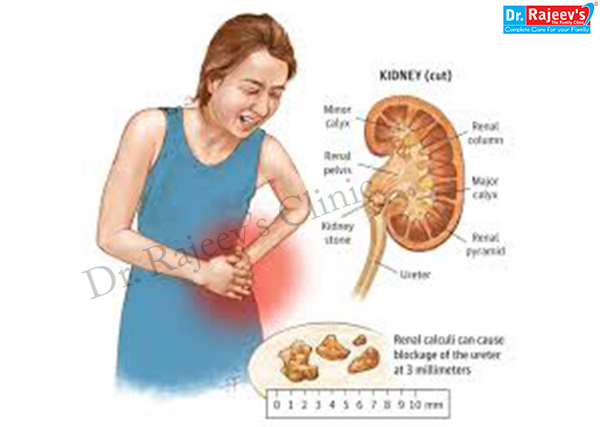

Patient gives a history of severe paroxysms of lancinating pain, starting in one loin and shooting down in front of the thigh, or testes, or vulva. There is also increased frequency of micturition with vomiting, shivering, sweating, pallor and a certain amount of collapse . These pains are followed by presence of blood and pus urine. The condition is RENAL COLIC.
Small stones may not cause any symptoms. Larger stones can cause renal colic, especially if they block a ureter. This is the tube urine travels through on its way from your kidney to your bladder.

Renal colic pain often comes in waves. These waves can last from 20 to 60 minutes.
Other symptoms of urinary stones include:
Renal colic happens when a stone gets lodged in your urinary tract, often in a ureter. The stone stretches and widens the area, causing intense pain.
A few factors increase your risk of getting urinary stones, including:
Renal colic is a symptom of urinary stones. It doesn’t have its own complications. If you don’t treat urinary stones, you can develop  complications such as urinary tract infection or kidney damage.
complications such as urinary tract infection or kidney damage.
To avoid getting renal colic in the future, take these steps to prevent urinary stones:
Before embarking on the medicinal treatment of these suspected cases of renal colic with calculi, investigate the size , shape and contents of the stone through x-ray, sonography and biochemical evaluation, only a small calculi can be removed by urinary flow; bigger ones may need lithotripsy or surgical intervention.
Treatment consist of two parts- one during an acute attack and the other is during the interval.
Treatment of an attack of renal colic consist mainly of relief in symptoms of pains, vomiting and collapse. At times, heat application may relieve.
Berberis vulgaris has radiating pains from the kidneys to the bladder. Pain from the kidney extends along the ureter of radiates to the liver, stomach and spleen, arresting breathing. Bubbling sensation in the region of kidneys. Frequent urination with the sensation as if some urine is left behind. Urine is thick, mucoid, bright red, turbid, yellow or sandy.
Calcarea carbonica suits an irritable bladder and renal colic; incontinence while walking, urine is dark brown, sour, foul or of a strong odour. Presence of white urinary sediment with milky urine, at times bloody. Other constitutional characteristic are also present.
Benzoicum acidum is indicated for insufficiency of the kidneys and excess of uric acid causing cystitis. Bed wetting, stains the linen brown. Uric acid diathesis. Pains suddenly change their locality.
Lithium carbonicum has soreness of the bladder; pain is in the right kidney and ureter, suits uric acid diathesis. Urine is scanty with much thirst. Turbid urine, with mucous; urine is scanty and dark, acidic, with sandy deposits.
Sarsaparilla officinalis has pain from the right kidney downwards. Urging to urinate before menses. Severe pain at the conclusion of urination. Renal colic and painful urination in children. Can pass urine only when standing, dribbles when sitting. Tenesmus of the bladder.
Ocimum canum suits uric acid diathesis. Urine highly acidic, leads to formation of spiky crystals of uric acid urine is thick, turbid, purulent, bloody; has brick dust, red or yellow sediment; it has the odour of musk. Renal colic with violent vomiting, especially right sided, use low potency in repeated doses.
Hedeoma pulegioides is more useful in female urinary conditions. Pain is more along the left ureter; dragging pain from the kidney to the bladder. Dull, burning pain over the left kidney. Burning irritation at the neck of the bladder causing a frequent desire to micture an inability to hold urine for more than a few minutes. Feels better by micturating.
RL24